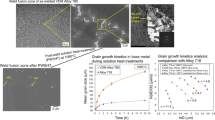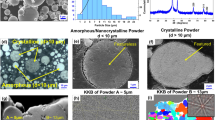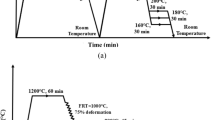Abstract
In this paper, the effects of cooling conditions on the solidification microstructure and mechanical properties of Al–18Si alloy were studied. Results show that the cooling rate up to about 250 K/s could be obtained with an ultra-low temperature copper tube in the process of melt rapid cooling + mold cooling, which could completely inhibit the precipitation of primary silicon and promote the formation of pseudo-eutectic structure in Al–18Si alloy. While in the existing research, the cooling rate was in the range of 150–200 K/s, which could only refine the primary silicon in the solidification microstructure of hypereutectic Al–Si alloys. With the change of cooling conditions, eutectic silicon changes from needle sheet with large lamellar spacing to fine sheet and then, too dense rod-like structure. The α-Al phase is transformed into a fine dendrite. The impact toughness, tensile strength, and elongation of melt rapid cooling + mold cooling Al–18Si alloy are 29.2 J/cm2, 241 MPa, and 6.4%, respectively. Melt rapid cooling + mold cooling is an effective method to inhibit the precipitation of primary silicon in hypereutectic Al–Si alloys.






Similar content being viewed by others
References
Alexander C, Marukovich E, and Martin S, Metals 10 (2020) 819.
An Y K, Liang L, Xu X L, Zhao Y H, and Hou H, J Mater Res Technol 11 (2021) 548.
Ao X H, Xia H X, Liu J H, He Q Y, and Lin S X, Comp Mater Sci 186 (2021) 110049
Cai Z Y, Zhang C, Wang R C, Peng C Q, Qiu K, and Wang N G, Prog Nat Sci 26 (2016) 391.
Chaiyawat P, Phromphong P, Ussadawut P, Limmaneevichitr C, J Rare Earth (2021).
Gu T, Pan Y, Lu T, Li C L, and Pi J H, Mater Charact 141 (2018) 115.
Haghayeghia R, and Timelli G, Mater Lett 283 (2021) 128779
Kumar D T A, Kumar K G B, Pattanaik A, and Mukherjee M, Trans Indian Inst Met 73 (2020) 3105.
Li P J, Nikitin V I, Kandalova E G, Nikitin K V. Mater Sci Eng A 332 (2002) 371.
Li Q L, Xia T D, Lan Y F, Zhao W J, Fan L, and Li P F, J Alloy Compd 562 (2013) 25.
Liang C, Chen Z H, Huang Z Y, and Zu Q F, Mat Sci Eng A 690 (2017) 387.
Lin G Y, Li K, Feng D, Feng Y P, Song W T, Xiao M Q, T Nonferr Metal Soc 29 (2019) 1592.
Liu M W, Zheng R X, Xiao W L, Li J, Li G D, Peng Q M, and Ma C L, Scr Mater 201 (2021) 113970
Ma P, Jia Y, Prashanth K G, Yu Z S, Li C G, Zhao J, Yang S L, and Huang L X, J Mater Res 32 (2017) 2210.
Ma G D, Li L, Xi S Y, Xiao Y, Li Y K, Yuan Z T, He Y H, Zhou R F, and Jiang Y H, Mater Charact 176 (2021) 111143.
Mao G, Liu S, Wu Z, Zhu C C, Gao W L, Mater Lett 271 (2020).
Miguel Á, Suárez R, Raúl P, Elia G P, Alfredo H, José F C, Mater Res (2022).
Samat S, Omar M Z, Baghdadi A H, Mohamed I F, Rajabi A, Aziz A M, J Mater Res Technol 95 (2021) 145.
Uhlmann E, and Jaczkowski R, Surf Coat Tech 352 (2018) 483.
Uzun O, Karaaslan T, Gogebakan M, Keskin M, J Alloy Compd 76 (2004) 149.
Vijayana V, Ravi M, and Narayan Prabhu K, Mater. Today: Proceedings 46 (2021) 2732.
Wang S, Liu Y, Peng H P, Peng X W, Wang J H, Su X P, Adv Eng Mater 19 (2017) 1700495.
Wang S, Fu M, Li X Z, Wang J H, and Su X P, J Mater Process Tech 255 (2018a) 105.
Wang J, Guo Z, Song J L, Hu W X, Li J C, Xiong S M, Mater Des 137 (2018b) 176.
Xu Y J, Deng Y, Casari D, Ragnvald H, Mathiesen, Li Y J, J Alloy Compd 832 (2020) 154948.
Xu G P, Wang K, Lv X, Li H N, Jiang H Y, Wang Q D, Ding W J, Mater Charact 178 (2021).
Zhang Y H, Ye C Y, Xu Y Y, Zhong H G, Chen X R, Miao X C, Song C J, and Zhai Q J, Metals 7 (2017) 184.
Zhang L, Chen S Y, Li Q H, and Chang G W, Mater Des 193 (2020) 108853
Zhang S Y, Wang X, Liu X, Mo Y T, Wang C, Cheng T, Ivasishin O, and Wang H Y, J Mater Res Technol 16 (2021) 922.
Zheng Z K, Ji Y J, Mao W M, Yue R, and Liu Z Y, Prog Nat Sci 27 (6), (2017) 1264.
Zheng Q J, Zhang L L, Jiang H X, Zhao J Z, and He J, J Mater Sci Technol 47 (2020) 142.
Zuo M, Liu X F, Sun Q Q, and Jiang K, J Mater Res Technol 209 (2009) 5504.
Acknowledgements
This project was supported by National Science Foundation of China (No. 52071032) and Postgraduate Research and Practice Innovation Program of Jiangsu Province (KYCX22_3034).
Author information
Authors and Affiliations
Corresponding author
Ethics declarations
Conflict of interest
The authors declare no conflict of interest.
Additional information
Publisher's Note
Springer Nature remains neutral with regard to jurisdictional claims in published maps and institutional affiliations.
Rights and permissions
Springer Nature or its licensor (e.g. a society or other partner) holds exclusive rights to this article under a publishing agreement with the author(s) or other rightsholder(s); author self-archiving of the accepted manuscript version of this article is solely governed by the terms of such publishing agreement and applicable law.
About this article
Cite this article
Zhu, Z., Zhou, H., Liu, Y. et al. Effect of Cooling Conditions on the Solidification Microstructure and Mechanical Properties of Al–18Si Alloy. Trans Indian Inst Met 76, 2827–2833 (2023). https://doi.org/10.1007/s12666-023-02980-8
Received:
Accepted:
Published:
Issue Date:
DOI: https://doi.org/10.1007/s12666-023-02980-8




